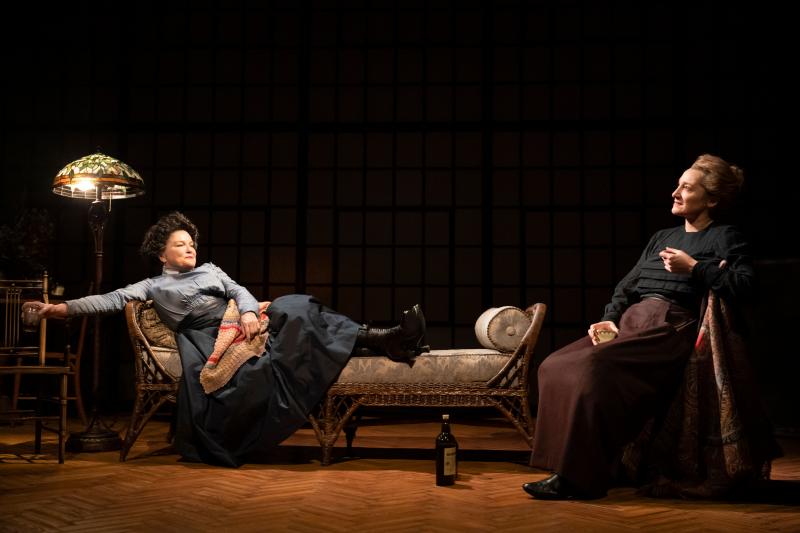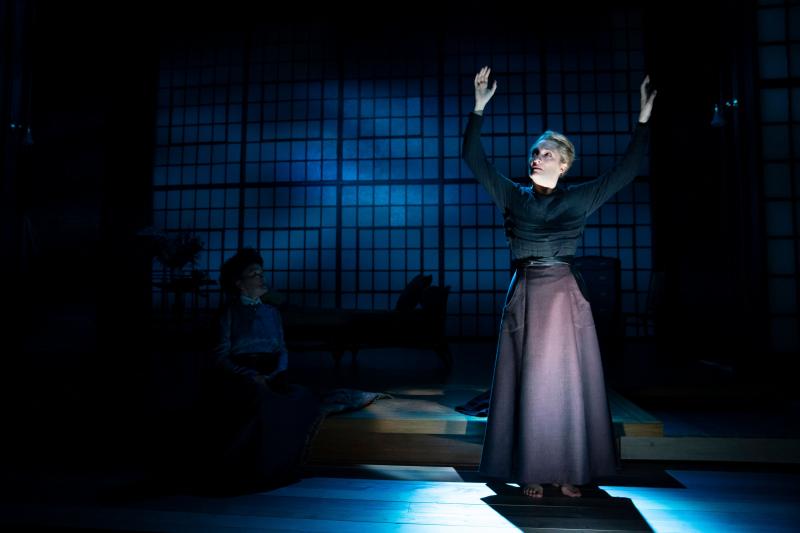Review: Kate Mulgrew and Francesca Faridany Muse Over Science and Sexism in Lauren Gunderson's THE HALF-LIFE OF MARIE CURIE
Roughly two months ago American Theatre announced that for the second time in the past three seasons, Lauren Gunderson had topped their list of the most-produced playwrights in the country, her 33 professional productions among the 385 Theatre Communications Group's member theatres easily surpassing second place finisher Lauren Yee's 18, Tennessee Williams' 17 and more than doubling the totals of August Wilson and Neil Simon. She came in at #2 on last year's list after her first #1 finish the year before. (For the record, Shakespeare, who would surely rank #1 every season, is excluded.)

(Photo: Joan Marcus)
And since her handful of New York productions haven't been of the highest profile, she's earned a reputation as the most popular living playwright in America despite not being very well known in the country's most theatre-centric city.
It's with that growing recognition of her national acclaim that the playwright's The Half-Life of Marie Curie has its world premiere in the largest Manhattan theatre to date to house her work, the Minetta Lane.
A two-hander starring Francesca Faridany in the title role - the two-time Noble Prize-winning scientist who coined the term "radioactive" - and Kate Mulgrew as physicist Hertha Ayrton, best known for her work in electrical engineering, the play certainly continues Gunderson's stated mission to write works that place women characters front and center, dealing with issues that may not be fully familiar to audiences.
This one has been commissioned by Audible, the company specializing in releasing downloadable audiobooks and other spoken word entertainment, that has taken up residence at the Greenwich Village Theatre, producing and recording numerous solo and small cast plays around 90 minutes in length, that focus on verbal storytelling.
"The moment an element transforms so fully that it is more other than self," is how Curie defines the term "half-life".
Regarding the work she pioneered alongside her late husband Pierre, it refers to radiation being the process by which an element changes itself entirely.
In terms of herself, it applies to the fact that, with Pierre having passed away six years ago, she's experiencing a life that is both more her own and more fully exposed to the sexism targeted at women of science.
It is 1911 and Marie Curie is the subject of a celebrity scandal for having a love affair with a man who, although married, is estranged from his wife. The press and public choose to vilify her as a wicked temptress while lightly admonishing him as a victimized unfaithful husband.
"Men get to have sex all the time. They don't mind what Einstein does with his evenings," her friend Ayrton flippantly remarks.
Up until that time, Ayrton's most public achievement was to redesign early electric lamps so that they wouldn't continually give off loud hissing and popping sounds. Fewer knew her for hiding suffragette activists from the police.

(Photo: Joan Marcus)
The premise of the play is Gunderson's imagined conversations between the two during a time when Curie was staying at the seaside home Faridany's rented in Hampshire. While the pressure of public scrutiny has undoubtedly taken its physical and metal toll on her, it will eventually be determined that her continual and casual exposure to radiation (such as the vial of radium she would wear around her neck as jewelry) before the discovery of its damaging effects will lead to her demise.
As one would expect, the two women bond through both their brilliance and the ways they are slighted by the patriarchy for being women, such as the Nobel committee's request that Curie not appear at her own prize ceremony and The Royal Society refusing membership to Faridany because, as a married woman, she was regarded as property of her husband and not legally a person.
And of course, there's the more confidential exchanges regarding love and sex. Gunderson displays a fine ear for banter ("Science would be so much better without all the scientists.") and, under Gaye Taylor Upchurch's sturdy direction, the two actors deliver them with aplomb.
But THE HALF-LIFE OF MARIE CURIE is at its best when educating audiences about the two women's achievements, particularly the life-saving devices they invented to protect front-line soldiers during World War I.
It may add up to a collection of talking points more than in-depth drama, but those seeking a good history lesson and vehicle that showcases two older women in interesting roles won't be disappointed.
Reader Reviews



